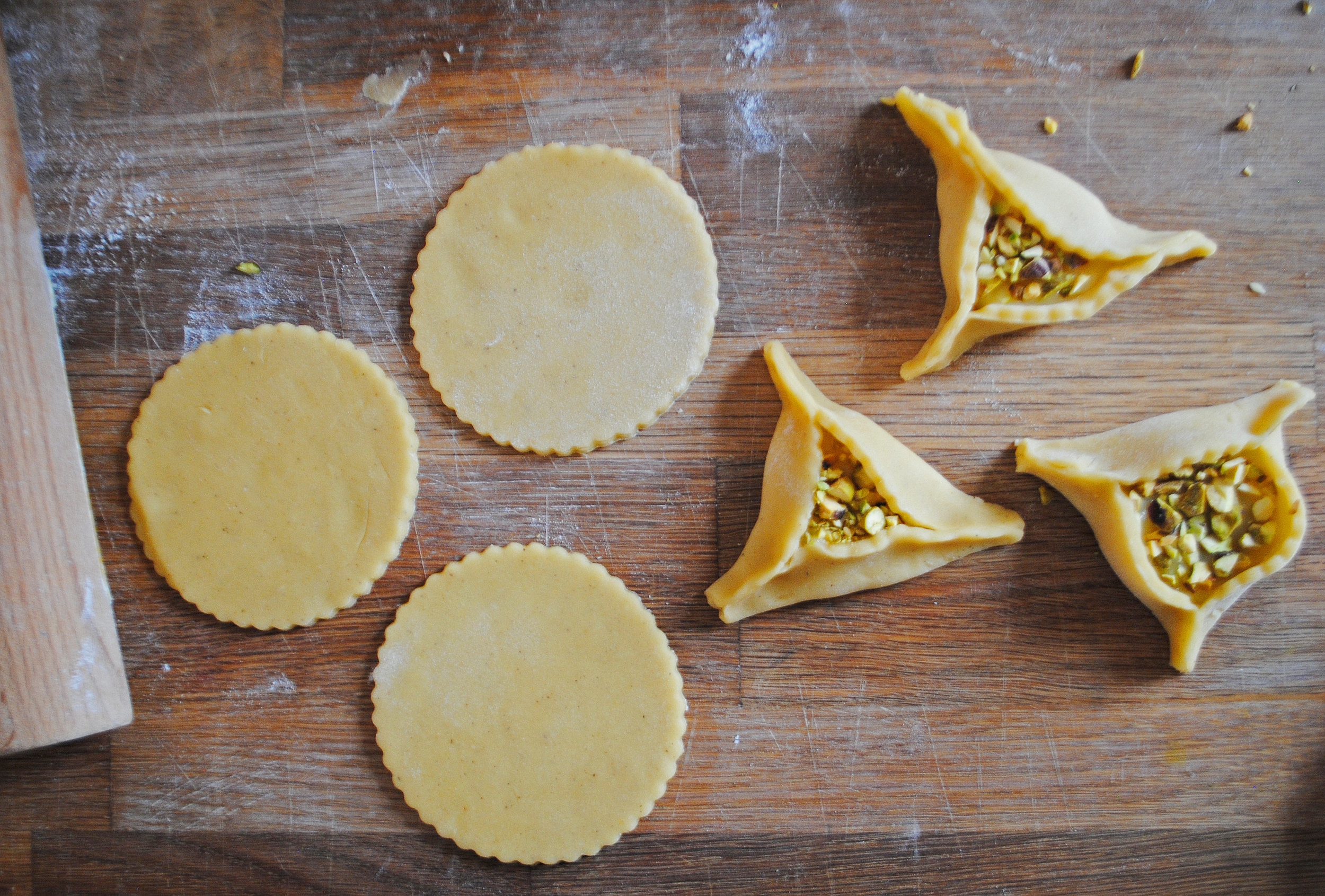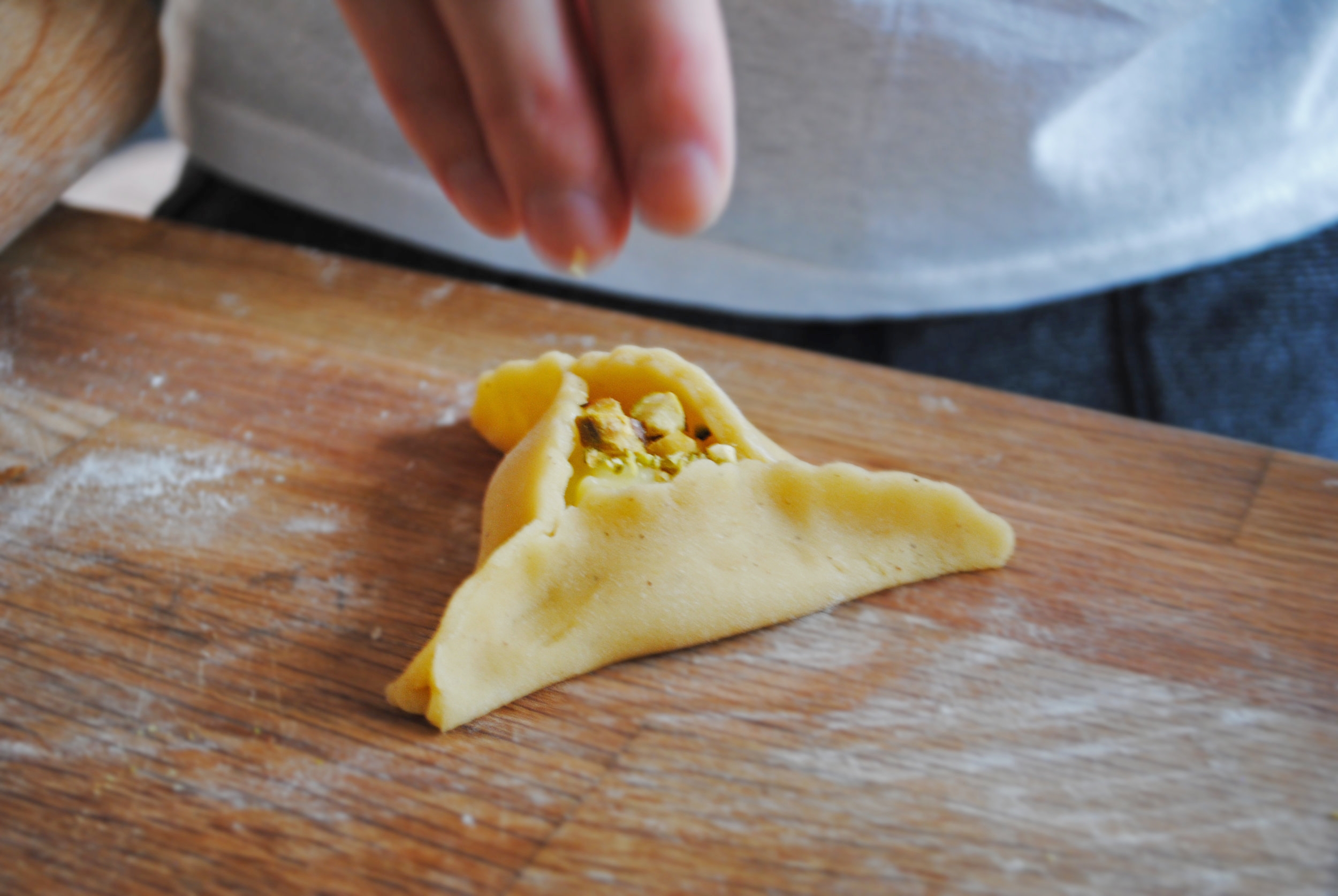LEMON BAR HAMANTASCHEN
While cooking, listen to this: Rise Up - Thomas Jack & Jasmine Thompson
Happy almost Purim friends! Time to get out those grogers and go hard on some hamantaschen.
"Um, Rina? What the hell did you just say?"
Glad you asked! Let's break that sentence down:
Purim: it's a Jewish holiday that starts tomorrow night and celebrates the victory of the Jews over their oppressors, which is what the majority of Jewish holidays are about. In this case, the oppressor is a man named Haman who plotted to kill all of the Jews living in Shushan (in part of what used to be Persia).
Groger: this is a noisemaker that's used during the reading of the story of Purim whenever Haman's name is said. We really hate that guy. These can be made out of pretty much anything - preschoolers make some bomb grogers out of paper plates and beans, for example.
Hamantaschen: why we're here!
In yet another example of a Jewish food that sounds like a sneeze, hamantaschen are triangle-shaped cookies filled with all manner of things. Super traditional hamantaschen are filled with things like poppy seeds and jam, but people can get pretty wild with Nutella, candy and unicorn dust, apparently.
But what's up with that name?
Remember that guy Haman from before? He wanted to kill the Jews, especially this one named Mordecai whom he was super jealous of, but failed and was sentenced to death by hanging. I grew up on the understanding that hamantaschen are shaped like Haman's tricorn hat, but the Hebrew word for hamantaschen is oznei Haman, or Haman's ears. And taschen doesn't even mean hat! So, huh?
Time has a whole great article about this, which you should read here. According to Gil Marks, who wrote the amazing Encyclopedia of Jewish Food, the phrase "Haman's ears" comes from a mistranslation by a Roman scholar and poet named Immanuel ben Solomon. It was customary in medieval Italy to cut a person's ears off before they were executed, and Immanuel argued that Haman received that special treatment before his death.
Marks believes that the first record of something called "Haman's ears" being something to eat comes from a 1550 play that was produced and performed at a Purim carnival in Mantua, Italy. The article goes on "The script contains a play on words in which one character thinks that the Biblical story of the Israelites eating manna in the dessert is saying that the Israelites ate Haman; another character responds with an interpretation that it must mean that Jews are commanded to eat oznei Haman."
Gross.
Anyway, around the 18th or 19th century in Germany and Eastern Europe a pastry pocket filled with poppy seeds got really popular and was dubbed a "mohntaschen," which literally means poppy seed pocket. The word ended up becoming a pun around Purim - oznei Haman plus mohntaschen made hamantaschen, and the name has stuck ever since.
So, yeah. The idea of eating a man's ears isn't an appetizing prospect, but apparently it's meant to teach us about taking something evil and making it sweet in return. Which is a beautiful idea! And it's what we're doing here with our hamantaschen.
Alyssa and I love lemon bars, as well as doing too much, so we made lemon bar hamantaschen just in time for Purim. The dough recipe comes from Deb over at smitten kitchen and has brown butter in it, which is what I want to fill my next bath with. The filling is a simple (I promise!) lemon curd, and it all gets garnished with some chopped pistachios. The result is a bright, not-too-sweet cookie that tastes like spring.
Purim is a reminder to not take ourselves too seriously - we wear costumes, we drink (it's actually a mitzvah to get trashed on Purim, fun fact), we shake noisemakers and boo like crazy people in synagogues. So when, for example, you make a batch of hamantaschen and they all pop open and leak in the oven because you went a little hard with the filling, laugh it off and make some more. Just make sure to pinch extra hard next time.
Love and meows, Rina
LEMON BAR HAMANTASCHEN
Triangle-shaped cookies, traditionally eaten on the Jewish holiday of Purim, filled with lemon curd and topped with chopped pistachios. Best eaten while fighting the patriarchy.
Yield: about 18 hamantaschen
Active Cook Time: 20m | Inactive Cook Time: 3h 15m (see note) | Total: 3h 35m
Category: Celebrate, Cookies, Purim, Sweet
Source: dough from smitten kitchen
Special Equipment: fine-mesh sieve or strainer, rolling pin, 3-inch cookie cutter (we went with a fluted one), cooling rack
Note: the dough can be made the day before and left in the fridge over night before it's rolled out, but you could also stick it in the fridge for 20-30 minutes and then go to town.
Ingredients
dough:
¼ cup (4 Tablespoons) butter
⅔ cup granulated sugar
1 teaspoon vanilla extract
2 large eggs
1 teaspoon baking powder
¼ teaspoon kosher salt
2 ¼ cups + 2 Tablespoons all-purpose flour*
lemon curd:
1 cup granulated sugar
1 Tablespoon fresh lemon zest
⅔ cup freshly squeezed lemon juice (do NOT touch that bottled stuff)
4 large eggs
Pinch kosher salt
10 Tablespoons (1 ¼ stick), cubed
1 Tablespoon fresh lemon zest
garnish:
finely chopped pistachios
*If you're in a more humid area, you may need more flour - you want your dough to be stiff and easy to handle but not tacky. Add a Tablespoon of flour at a time and mix until you reach the right consistency.
Instructions
Brown the butter: this is an optional step, but it is SO worth it - it'll give the dough an extra nutty flavor. Melt the butter in a small pan on medium heat. Allow to cook until it starts to smell nutty and develops some brown bits, which may take a few minutes. Do NOT leave your post while browning butter - the butter knows exactly when you turn your back and will burn instantly. Once the butter's brown flecks have turned a toasty, caramel color immediately remove from the heat and transfer to the bowl you'll be using to make your dough. Allow to cool slightly.
Make the dough: in the bowl with the cooled brown butter, mix in the sugar and vanilla - I used the paddle attachment with my stand mixer, but Deb at smitten kitchen goes in with a whisk and then switches to a spoon. Crack 1 egg into a bowl, checking for shell (and, if kosher-observant, blood spots) then add in and mix. Repeat with second egg, then the baking powder and salt. Add the flour one cup at a time, mixing completely after each one. Add the final 2 Tablespoons and mix, and add more flour a Tablespoon at a time if necessary. Divide the dough in half, cover in plastic wrap, and stick in the fridge for at least 3 hours, or even overnight. You can also stick it in the freezer for 20-30 minutes if you want to get cracking.
Make the lemon curd: while the dough is chilling, place a sieve/strainer over a heat-proof bowl. Whisk together the sugar, lemon juice, eggs (check them first!) and slat in a medium saucepan. Add the cubed butter and turn the heat up to medium-high. Whisk constantly while it cooks, until it thickens up and can coat the back of a spoon. Again, do NOT turn your back on this. Small bubbles will form around the edges, but make sure the mixture doesn't boil. Once thickened, immediately pour into the sieve/strainer that's sitting in the heat-proof bowl. Add the lemon zest to the strained curd and stir to incorporate. Place some plastic wrap directly onto the curd and stick in the fridge for at least 3 hours before using.
Hamentaschen prep: preheat the oven to 350 F and line two baking sheets with parchment paper. Set up a cooling rack as well.
Form the hamantaschen: flour your work surface and rolling pin. Roll out the chilled dough until it's ⅛-inch thick. Make sure to turn the dough after every few rolls and to be liberal with the flour so that the dough doesn't stick to the surface. Using a 3-inch cookie cutter, cut out rounds of dough, re-rolling the dough to get as many hamantaschen out of it. Next, place a small dollop of lemon curd into the middle. Pinch the top of the circle together, then fold the bottom up and pinch the two corners. Make sure they're really pressed together or they'll open in the oven. Garnish with some pistachios.
Bake: place the hamantaschen about 1-inch apart on the baking sheets and bake for 11 minutes. After the 11 minutes are up, check on them once per minute until they start to go golden brown along the edges (for us it was 14 minutes total). Use a spatula to place them on the cooling rack and allow to cool completely before eating.
To keep: in an airtight container or zippered plastic bag they'll keep for up to 1 week, and can be frozen for even longer.











